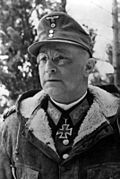| 20th Mountain Army | |
|---|---|
| German: 20. Gebirgs-Armee | |
 | |
| Active | January 1942–1945 |
| Country | |
| Branch | |
| Size | Field army |
| Engagements | World War II |
| Commanders | |
| Notable commanders | Eduard Dietl Lothar Rendulic |
The 20th Mountain Army, initially known as the Lapland Army, was a field army-level military formation of the German Army during World War II.
Contents
The 20th Mountain Army was one of the two army echelon headquarters controlling German troops in the far north of Norway and Finland during World War II. It was formed in June 1942 by renaming the Lapland Army command, which had been formed in January. On 18 December 1944, the 20th Mountain Army took over the role of Wehrmachtsbefehlshaber Norwegen from the dissolved Army Norway.


